This is one of my essays on 18th century cowkeeping. On the left are links to the sections in this essay and its drill-down extended footnotes, and to the Contents page. To keep it simple, my bibliography and list of useful websites is in one place at the end of the home page.
Demand and supply
In 1700 there were half a million Londoners willing to drink their daily glass of milk, and most of the cow-keepers were in fields on the outskirts of town. One woman can only milk eight or nine cows twice a day, so each cow-keeper either had a large staff or had contracts with a number of milk-dealers who at 3am would trundle noisily out with their carts, churns and milk-maids, milk their allocated cows, and trundle back to their local customers. In 1731, one poor milkmaid didn't return from her daily trudge:

Her employer was one of Mr Ferriman's contractors, with a business in Panton Street, which is half-way down the West End's Haymarket and now leads to Leicester Square. The Horse Ferry was at the other side of Westminster, so Mr Ferriman must have been based in Tothill Fields. This milkmaid had a long trip to make twice a day, and would probably have regularly walked that track past Millbank (illustrated in the Introduction).

But how many cows were there? In his 1794 Survey of Middlesex for the Board of Agriculture, when the population had doubled to one million, Mr Foot counted 8,500. Was that enough?
The estimates of a cow’s yield varied from 530 gallons to 820 gallons a year, depending on breed, diet and decade. If a hypothetical average cow produced 675 gallons over 330 days (allowing for calving and off-days) she would give about two gallons a day. Mr Foot's Middlesex cows would therefore produce 17,000 gallons a day. Was that enough?
One mid-19thC survey said that most city people actually drank 2/7th of a pint a day or less, not a whole pint. In 2007, the average daily liquid milk consumption in Britain was 1.575 litres a week [DEFRA], roughly half a pint per person per day.
This is an English 1/4 pint of milk = 5 fluid ounces. An American quarter-pint = 4 fluid ounces and more accurately reflects the original Winchester measure. The metric equivalent is 142ml or 14cl.

In October 1772 the Public Advertiser published a notional budget for a couple with six children [the spending habits of a clerk, and of this notional family, is given in full in other essay, here: the cost of living]. The report said the family's daily spend on milk was 1d. The autumn of 1772 saw a doubling of the price of milk so it is not clear which price was used. At at the new price - 2½d per quart - the family of 2 adults and 6 children would be sharing one pint of milk a day. If the price used was the old price (1¼d) it would mean that each family member was drinking ¼ pint, which brings the daily demand down to 15,625 gallons, or 7,800 cows. This is much closer to Mr Foot's actual head-count. So poor families had to reduce their milk consumption when the price went up but they still each got a bit, and they ate cheese and butter as well, brought in from the country markets (where they were sold wholesale in firkins, weys and leads!). Many more customers would grumble but be able to pay, and those customers expected more than a daily ¼ pint for each member of their household, and for their puddings and pastries and frequent cups of tea, hot chocolate and coffee - how else could they make a latte in the coffee-house?
There certainly was not enough milk to meet demand and the practical solution for the milk-dealers was to dilute it.
Adulteration
The milk dealer's friend - the 'black cow'

Milk is largely water anyway. Morton (1868) said that the 'natural proportion' of water was about 87%, so adding a bit more seemed the obvious thing to do. On the farm, the cow-keeper provided a pump for cleaning and watering his cattle, and the milk-sellers who came to milk the cows might use this - jokingly known as the 'black cow' - to dilute the milk immediately. However, if the dealers had any distance to travel, it made more sense to wait until they had carried the milk home, which meant that the water came from domestic wells which could be too close to the nearby cess-pits and open drains of the crowded streets. Cholera was a common consequence.
Another way of cheating was to skim the cream off first (illegally, and sell it separately) which meant that the resulting milk was even thinner. Or the servants of the big houses demanded a percentage – Mr Morton quotes a contributor to his report:
Servants' perks
"The bar to the sale of pure milk among the better classes is the system of percentages to servants. They all expect 5% on the gross amount of their master’s bills, and this is just about what would be net profit on an honestly-conducted West-end business. If this is not paid the milkman is ‘worked out’. So, to avoid this unpleasant process he adds water sufficient to pay this tax and, as that seems to pay well, he soon doubles the quantity."
The scandal of milk dilution was so well-known that Charles Dickens wrote a short story The cow with the iron tail published in Household Words on Saturday 9th November, 1850 (price 2d), which starts with a description of the pump in a court-yard in High Holborn. The local blackmailing barber calculates the dilemma of demand-v-supply: given a population of two million drinking ½ pint each and a cow producing 10 quarts a day then it would need 50,000 cows to meet the demand, but there are only 20,000. The barber threatens to expose the meek dairyman, accusing him of diluting the milk by adding sometimes a pint and a half of water to every two pints of milk, then adding pulverised calves brains to “give it the thickness it has lost, and restore its colour”.
Much less savoury additions

I read elsewhere of sheeps’ brains being added, and of snails being dropped into the churns so that the bubbles they produced gave the milk a freshly-poured appearance (I had to guess where the bubbles might come from). I do not know Dickens’ source for 20,000 cows, but the 1865 RSA report includes a statement from a Mr Campbell of Rugby, that the number of cows kept [in Rugby] was equal to one cow for every 70 of the population, ‘very similar to what was the case in London’. The 1851 census of London counted 2,362,236 people which, applying Mr Campbell's ratio, would equate to nearly 34,000 cows. In his 1865 report to the Royal Society of Arts, Mr Morton said there were 24,000 in the metropolitan district, with milk from a further 4,000 being brought in by train. That's close enough.
Herd size and location
A cow cost the equivalent of a labourer's annual wage
One factor which is hard to comprehend now is just how expensive cows were. In the mid 18thC, when a London craftsman was fortunate to earn £40 a year and labourers got about £25, a milch-cow cost £18 [Middleton]. In 2000 in England the average wage for a labourer was £15,000. Using the same ratio, a cow would cost £10,800, yet the Dept of Ag says (2006) that a milk cow actually costs about £600. Even when I was researching 1880s Swaledale, a cow cost the same as a year's pay for an ag lab. In relative terms, the 18thC cow-keeper had to find a huge amount of capital to populate his cow-stalls.
In 1798 Middleton's report to the Board of Agriculture quoted the numbers collected in 1794 by Mr Foot: that London was supplied by 8,500 cows – 7,200 in Middlesex, 1,300 in Kent and Surrey. Here is where the cows were kept (his list goes clockwise from the river). These places are marked in yellow on the map below, which was published by Samuel Leigh in 1819 (and redrawn by John). You can see the extra bridges built across the Thames - Battersea, Waterloo, Blackfriars and Southwark - since those shown in the 1746 map in the Introduction. The other huge difference is the new network of canals.
| District | cows |
| Tothill Fields + Knightsbridge | 205 |
| Edgware Road | 550 |
| Paddington +Tottenham-Court Rd + Battle-Bridge +Gray’s-Inn-Lane +Bagnigge-Wells +Islington | 3,950 |
| Hoxton | 150 |
| Ratcliffe | 205 |
| Mile End | 406 |
| Limehouse | 180 |
| Poplar | 70 |
| Bethnal-Green | 200 |
| Hackney | 600 |
| Bromley | 160 |
| Bow | 100 |
| Shoreditch + Kingsland | 200 |
| Odd Cows | 224 |
| MIDDLESEX TOTAL | 7,200 |
| Deptford + Rotherhithe + Greenland Dock + New Cross + Bermondsey | 681 |
| Lambeth + South Lambeth + Kennington Bridge + Cold Harbour + Peckham + Newington + Camberwell | 619 |
| KENT+SURREY TOTAL | 1,300 |
The area labelled Regents Park was, in 1746, part of Lamb's Conduit Fields. It had been leasehold farmland and small-holdings since 1649 and was so used when Mr Middleton conducted his survey in 1798, which explains the huge number of cows assigned to the Paddington-Islington district to the north of the city (the main weekly cattle market was held in Islington). By the time the 1819 map was published, the crown leases had expired and the Prince Regent had commissioned Nash to create what became Regent's Park, which would have meant some hasty shifting of a lot of cows.
The area named Battle Bridge was about where King's Cross railway station is now; Bagnigge Wells house and gardens was where in the 1660s Nell Gwynne held her lively parties for King Charles and his brother. By 1795 it had decayed into a public park and was described then by Daniel Lysons as 'a noted place of entertainment, much resorted to by the lower sort of tradesmen' [British History Online].
Greenland Dock must have been an early name for the Surrey docks on the south bank of the Thames, opposite the Isle of Dogs.
a map showing London's urban dairy farms
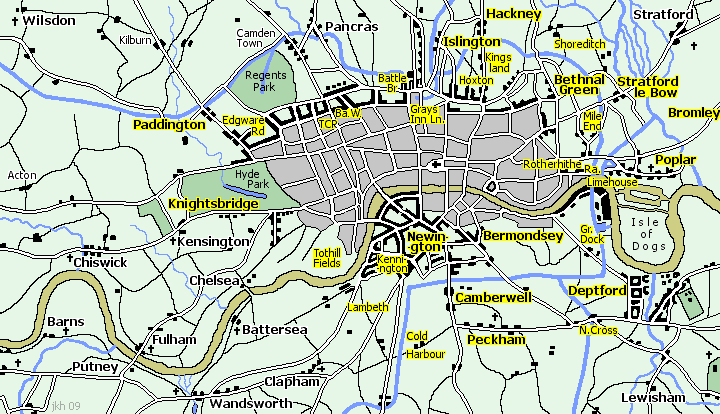
It seems reasonable to accept that there were about 8,500 cows in 1794. But how big were the herds? The auctions taking place in the 1750-70s suggest that a herd of 80 or 100 was not unusual. A 1781 letter to the Westminster Chronicle said:
"... the Cow-keeper had, ten years ago, such a great call for that article [milk], that he was enabled to keep constantly forty or fifty cows; whereas, at the present period, he cannot keep half that number."
which puts a 1780s herd at 25; this seems a bit low. In his 1798 survey, Middleton reports that Mr West of Islington kept 800 beasts across different farms, but I suspect this was most unusual. In February 1796, the Evening Mail carried an editorial which stated ‘London is supplied with milk by about thirty cow-keepers’. This is one of the rare times when numbers are mentioned but I have no idea of the reporter’s source, and the numbers just do not tally. Given 8,500 cows, and the 1781 average herd of 25, that means 340 cow-keepers, not thirty. Maybe the Evening Mail reporter was simply counting the districts named in Middleton’s report (listed above) – thirty-three districts. That makes more sense, but shows an unrealistic expectation that thirty cow-keepers could manage 8,500 cows.
The bankruptcies notified in the newspapers of 1755 to the 1770s give clear indications of herd size. Bankruptcy led to auctions, and the auction advertisements usually gave details. The adverts in the following transcripts give us some real numbers, as well as an idea of the equipment needed:
- 1755: Joseph Walker of ‘near the Foundling Hospital’ had to sell his entire stock of 100 cows.
- 1762: William Reaves of St George’s Fields advertised 41 Milch Cows, one Bull, all the Carts and Harnesses, Horses, and a strong Mare, five Sows, two Boars, ten Pigs, Harrows and Plough, a Stack of fine Hay, of about twenty Loads, and a large Parcel of Dung.
- 1765: Mr Bryant Davis of Shoreditch: 60 fresh milch cows, some in calf; 2 bulls, 3 horses, a single horse chaise, broad and narrow wheel carts, and other implements, boards, old wood, &c. in premises with housing for 14 horses and 80 cows, and 18 acres.
- 1770: Mr Thomas Wallington of Hyde-park-corner: his entire stock of 30-40 cows and several useful geldings of the drawing kind.
- 1773: Mr Joseph Ennever of Bow saw difficult times coming. In 1770 his Essex farm at South Ockendon Hall was cleared of twenty-nine fine heifers, nine cows, four calves, two bulls, seven horses and colts, a good waggon, two strong dung carts, a loading cart, a large calf cart, a small market cart, ploughs, harrows, and all kind of barn utensils, cart and plough harness, a parcel of old iron, one hundred hurdles, a stone garden roller, several cucumber frames and lights. It did him no good. In 1773 he was forced by bankruptcy to sell his cow-keeping business in Bow, and all his furniture. The auction contained four draught geldings, one saddle ditto, 21 milch cows, two broad wheel carts, one hay-cart, with ladders &c, a light errand cart, iron axle trees; six harrows, one plough, sundry cart and plough-harness, sundry sacks, a large iron beam, sealer, and iron weights, a malt-mill, and sundry implements in trade, also a mashing-tub, a large brewing copper, and some iron-bound casks, &c.
- 1775: Mr Thomas Porter of Highbury, Islington, retired and sold 100 milch and in-calf cows, plus bulls and pigs, 150 loads of hay, fourteen carthorses, three waggons and several carts.
- 1777: Mrs Helenor Gardner of Marybone was made bankrupt and sold a large Brewing Copper, 30 cows, three calves, two bulls and two horses, with 150 load of hay, one waggon and two carts. And some dung.
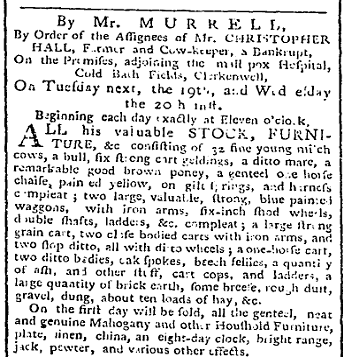
And at last I come to the 1778 advertisement which originally sent me off into a highly diverting investigation of London’s sewers and drains. Mr Christopher Hall had a farm at Cold Bath Fields, Clerkenwell, next to the smallpox hospital, and in 1778 his creditors forced him to sell :
"32 fine young milch cows, a bull, six strong cart geldings, a ditto mare, a remarkable good brown poney, a genteel one-horse chaise, painted yellow, on gilt springs, and harness compleat; two large, valuable, strong, blue painted waggons, with iron arms, six-inch shod wheels, double shafts, ladders, & c. compleat; a large strong grain cart, two close-bodies carts with iron arms, and two slop ditto, all with ditto wheels ; a one-horse cart, two ditto bodies, oak spokes, beech fellies [felloes? =rims], a quantity of ash and other stuff, cart cops, and ladders, a large quantity of brick earth, some breese, rough dust, gravel, dung, about ten loads of hay, & c. On the first day will be sold, all the genteel, neat and genuine Mahogany and other Household Furniture, plate, linen, china, an eight-day clock, bright range, jack, pewter, and various other effects."
Many cow-keepers kept stock other than milch-cows. Store pigs – weaned but requiring further feeding before slaughter [definition from DEFRA] – got a regular mention in the bankruptcy sales and they must have provided a steady subsidiary income for the cow-keeper and his family. William Deall kept asses and goats with his herd near the Green Man in Kilbourn Road, Paddington. Most had a surprising number of horses - Patrick Smith of Battle Bridge had 21 cows and 10 horses. John Richmond in Park Lane had 60 cows but he also had 12 stout geldings and five carts, which makes me wonder if he was also in the night-soil business. Mr Samuel Higgins of Stones-End, Dirty-lane, near the King's Bench, certainly was - as well as 40 cows and several grain carts, he had 'eight fresh geldings of the Draught Kind; three Machine Night Carts, almost new, built upon a new Construction', of which he was clearly very proud. One rich cow-keeper kept peacocks and fancy hen breeds, and their theft hit the newspapers.
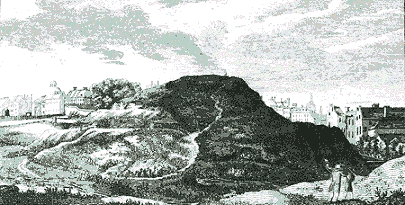
A lot of the auction adverts included dung. It must have piled up quickly and I can imagine a busy cow-keeper saying to himself “I must get that lot shifted” and never quite getting round to it.
Here is the illustration of the Fleet River skirting the muck heap at Cold Bath Fields. Since this was also a designated lay-stall for the borough Scavengers and night-soil men, I don’t think we can blame Mr Hall’s cows entirely.
From these auction notices, and other reading, thirty cows seemed to be the minimum herd, with eighty or a hundred not unusual. Any nearby land which could be used for grazing or growing crops was a bonus, and it is clear that a range of sturdy waggons was essential equipment.
Waggons
The cow-keeper auction notices described many different types of transport - a narrow-wheeled short cart, hay carts with broad wheels and ladders, grain carts, six-inch wheel rubbish carts, a loading cart, a calf cart, a small market cart, a light errand cart, a close-body cart, slop carts, a brick cart, a caravan on springs, waggons with iron arms and double shafts, and many spare parts, including mysterious ladders and copses. I searched for an explanation of cart terminology and found an expert who very kindly sent me the following explanation and illustration:
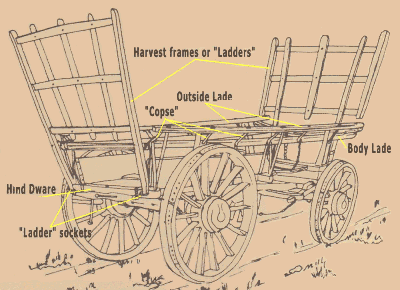
"The function of the Harvest Frames of Ladders was to increase the capacity of carts and wagons to carry lighter and bulkier loads at harvest time, like hay, corn or hops. Notice the two iron Ladder sockets, (fixed to the Hind Dware) in which the Ladders were held. The Ladders would of course need extra support, and this was provided by a length of chain with a hook each end. One hook was in an eye-bolt fixed to the Ladder, the other hook was on the rearmost Copse. The purpose of these Copse (there are six on each side of the wagon) was to extend the width of the waggon slightly – outwards and upwards. The lower part of each Copse was fixed to the Body Lade and the upper part of each Copse was fixed to the Outside Lade, extending the width."
Then I found this illustration of a Sussex wheelwright’s workshop in the Quennells’ History of Everyday Things in England. In a Gloucestershire museum we saw a similar waggon, described by a Mr William Marshall in 1789, who said the price of a wheel was £20 to £25 according to the size and the strength of the tire, and the weight was 15 cwt to one ton.
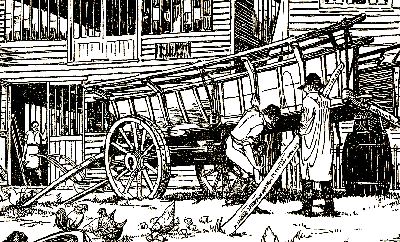
This waggon is without its harvest ladders – and without its back wheel, since the whole back end is being supported by a barrel and a block of wood. But I was surprised at its size – it would hold a lot of turnips. But then it needed to. The cow-keeper's waggons moved huge quantities of food in from the countryside – turnips and hay in winter, grass in summer – and dung in the opposite direction.
Very occasionally the newspapers gave useful data: in October 1800 the Observer said that the weekly diet for one cow was 14 bushels of turnips, 7 bushels of grains and one truss of Hay.
A small diversion: since a bushel measured dry volume rather than weight - I explain the Winchester measure system in another essay - it is hard to picture the stack of turnips, but 1 bushel = 4 pecks OR 8 dry gallons OR 128 pints. 128 pints is about 65 litres. An old-fashioned black plastic dustbin holds about 100 litres, so each cow required roughly thirteen dustbin-fulls of food a week. Which means that a herd of 40 cattle required over 500 dustbin-fulls a week.
All of this had to be shifted by hand and then transported to the cow-house, usually in the bad winter months where the roads would be rutted and flooded. Sturdy waggons and strong horses were essential, as was the address of a good wheelwright.
Farm size
Farm size varied from 6 to 100+ acres. This 1775 farm advert sounds just right:
"Grove Farm, in the parish of Kingsbury, near Edgeware, Middlesex, a Much improved Leasehold Farm, in excellent condition, situate at the Hyde, in the parish of Hendon, with the present growing crop; consisting of eight acres of wheat, and six of turnips, the remainder [unspecified acreage] in order for Lent corn. The farm would suit a London cow-keeper, being fine turnip land, and lying close to the road, five miles and a half from town. At the same time will be sold a stack of hay well got in, containing about 75 load; a bay of rowen [= 2nd crop of hay], several hundred load of dung, four shod-wheel carts and harness, six young strong draft horses, a cow and calf, two coppers, brewing utensils, and some household furniture."
Whoever owned this farm would probably stay out of town and contract with milk-dealers, like the employer of the poor squashed dairymaid did with Mr Ferriman, or maybe a town-based cow-keeper rotated a small supply of milking cows from the out-of-town farm, like the Golden Lane cow-keeper I discuss at the start of the Introduction.
Quite a few adverts for lost or stolen horses directed the finder to a street-based contact as well as the out-of-town owner, implying a mutual trust and familiarity. Back in 1726, Mrs Clarke and Mr Robert Gundrey might have had one of these mutually beneficial relationships.
a very unfamiliar view along Oxford Street! This turnpike gate was roughly where Marble Arch is now, but there are fewer sheep these days
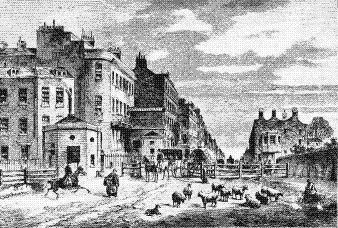
Mr Gundrey, who reported the loss of a chestnut gelding from his Grounds near Hide-park Corner, advertised that information could be left with Mrs Clarke, cow-keeper in Strutton Street, near Hide-park Corner. Now I cannot find a Strutton Street, even on the old maps, but there is still a Stratton Street, just along Piccadilly near Berkeley Square, and that would be a very good site for a small cow-house, near those posh Mayfair establishments and Hyde Park Corner. Mrs Clarke could quickly swap her beasts when their yield dropped, or send them out for grazing in the fields alongside Kensington Gore.
This is an 1820 view from the top right-hand corner of Hyde Park, looking east along what would become Oxford Street. This was Tyburn and the turnpike gate is about where Marble Arch is now. You can see how abruptly the buildings stopped and the country-side began, and one hundred years earlier Mr Gundrey could well have been regarded as 'out-of-town'.
Here is another attractive-sounding farm. The Post Man of January 1709 carried this advertisement:

"At Tottenham Court, near St. Giles's, and within less than a mile of London, a very good Farm House, with outhouses and above 70 acres of extraordinary good pastures and meadows, with all conveniences proper for a cowman, are to be let, together or in parcels, and there is dung ready to lay on."
"Enquire further at Mr. Bolton's, at the sign of the 'Crown' in Tottenham Court aforesaid, or at Landon's Coffee House, over against Somerset House in the Strand."
Tottenham Court was in Camden Town, at the top right-hand corner of what would become Regent’s Park – marked on the 1746 map as Lamb’s Conduit Fields – an ideal spot from which to supply customers in north London.
In 1728, when Mrs How of Islington died, she had been a cow-keeper with 80 acres of pasture close to her farmhouse. Her stock of cows was advertised for sale; unfortunately the advertisement did not say how many although, according to Lord Winchelsea's correspondent the pasture might have supported 40 cows. In 1736 another farmhouse was advertised in Shoreditch, this time for sale, with 100 acres of meadow and pasture. A quick look back at the map shows that these large farms were well clear of the built-up city streets, so grazing space was available.
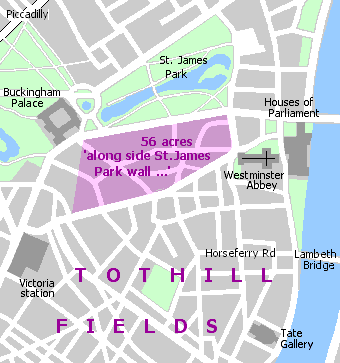
But this next advertisement, from the London Evening Post of 16th November 1736, was for a 56-acre farm in Pimlico, ‘along side St James’ park wall’, with housing for 80 cows, a 7-horse stable, and a carthouse, recently in the occupation of John Hugger and now being offered for immediate letting by Mr Andrews of Grosvenor Street. This was much closer to civilisation. I show it here superimposed on a modern map, because it now seems so incongruous.
I cannot locate the 1736 address of Pimlico Gate on any modern maps (or indeed on any old ones) so I am not sure exactly where the farm would have been. Mr Andrews’ house in Grosvenor Street was in Mayfair, just off the top of the map, between Piccadilly and Park Lane. Buckingham Palace did not become the monarch’s official residence until 1837 but it evolved from a town house owned by the Dukes of Buckingham and in 1762 it was bought by the King. The present Houses of Parliament were built after 1834 but the earlier parliament buildings had been on the same site.
In November 1737 Mr Andrews placed another advertisement, this time for a 64-acre farm adjacent to the Horseferry. These farms must have occupied the space identified on the 1746 map as Tothill Fields, although it seems that in 2009 all that is left of that earlier huge open space is a playing field. I suppose if you were the cow, it didn't matter much where you were kept, as long as you were fed and milked regularly.

A day in the life of a cow
In 1794 a Mr Foot published a Survey for the Board of Agriculture. In the section on Cowkeeping he gave details of yield, diet, pricing, and lifespan for a working milch cow. Extracts were published by the Whitehall Evening Post and you can drill down to a transcript here. His article also contained a typical timetable, which I give below. John Chalmers Morton's 1868 report gives similar detail and you can read his report online at Google books (I am sorry I can't easily make a link but it works if you search on name +date +cowkeeper).
- 3am breakfast: a half-bushel basket of grains
- 4-6.30am milking
- 6.30am a bushel of turnips each then 1 truss of hay per 10 cows
- 8-12 loose in the yard
- 12 back into the stalls, lunch as breakfast
- 1:30 second milking, then turnips and hay as before (Sept to May) - in other months got grains (stored in purpose-built pits for all-year feeding), cabbages, tares, rowen, and nights in the field.
- 6pm back into the stalls for the night
Mr Foot said that good milkers were kept for five, maybe up to seven years, then fattened up and sold off. At the sale, a careful cowkeeper would aim to get between 80% and 90% of the price he originally paid.
In 1798, in a paper included in the Reports of the Society for bettering the Condition of the Poor, Lord Winchelsea reported that his cottagers on poor land required three acres for each cow, although a highly-informed contributor to the Lloyd’s Evening Post in October 1800 hoped that this would be halved on the highly-manured [with night-soil and animal dung] pasture around London. You can drill down to read my transcript of the whole Post letter, which contains detailed costs of both feedstuff and labourer requirements, if you want to read it all.
Distemper
This is Necklace, Smithfield's 1846 prizewinning cow
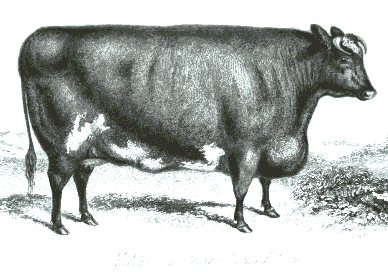
Despite the hefty appearance of Necklace, the articles and reports I have read suggest that cows are delicate creatures, and prone to illness. The slightest discomfort could reduce their yield – the milking parlour might be too hot, too cold, too draughty, too stuffy. A good cow-keeper made sure his beasts were gently introduced to their new quarters, giving them time to settle in and settle down, and quarantining them when infectious.
If the cows were put out to grass, then they were given enough space. It cost three times as much to feed a cow with brewers’ waste, oil-cake, turnips and hay than it did with field grass, but the yield was usually much improved and where possible the cow-keeper combined summer-time grazing with winter indoor feed.
The first distemper scare I found reported in the newspapers was in September 1714. British History Online has the regular reports being made during the outbreak to the Treasury, you can drill down to a full transcript here. Thirteen Hackney cow-keepers quickly placed an advertisement in the Post Man reassuring their customers that ‘cows when taken ill of this Distemper give no Milk” and that ‘we whose Names are here underwritten do certify, that all the Cows belonging unto us are in perfect Health’. The notice was signed by Ralph Harwood, Joseph Green, John Woodfield, William Eden, Philles Carnel, Walter Burton, Richard Ivory, Ann Burton, Samuel Fish, Abraham Woodcock, Edward Elderton, Henry Burton, and Samuel Paine. Two other cow-keepers, Christopher Capper and Benjamin Coker, about whom I write more later, were also affected.
A further outbreak of distemper in 1745 brought swift action from the Privy Council, who issued a series of Orders (my full transcript is here) and set up an expert Commission to enforce the fast identification and slaughter of infected cattle. Joseph Walker, of Clare-Market, in the County of Middlesex, Butcher, John Lane, of Islington, Cow-keeper, Thomas Rhodes of the Parish of Pancras, Cowkeeper, Edwards Tomkins, of Mansell-Street, Goodman’s Fields, Butcher, and John Penny, of Dyot-Street, in the Parish of St Giles in the Fields, Butcher, were to be their Surveyors and to ensure that immediate slaughter and burial in lime, ten feet deep, of carcases and slashed hides. There would be a grant of nine shillings for each hundred bushels of lime so used.
The outbreak attracted this recipe from an anonymous clergyman, published in the Westminster Journal of 23rd November:
"For the PUBLIC GOOD - A RECEIPT for the MURRAIN
"Make five or six incisions with a sharp-pointed pen-knife into the dewlap, where it hangs the fullest, and put into each hole a suitable piece of black helebore. If your cattle live till the part swells, they will recover. By a Clergyman"
And this more exotic and complicated recipe in the same newspaper came from the King of Sweden’s Printing House:
"Take of the roots of Snake weed, an ounce and a half; of Camphire, an ounce and half; of Valerian root, an ounce and half; of the roots of Elicampane, two ounces; of the roots of Lovage, two ounces; of Laurel Berries, six ounces; of the roots of Angelica, and of Carline thistles, each one ounce and half; of Agaric, an ounce and half; of the roots of Masterwort, one ounce; which ingredients being reduced to powder are to be mixed with sixteen ounces and a half of common Salt; Make a ball, and give it to the cow."
Unfortunately the instructions did not include how much to give the cow at one time, or how often.
Despite all these problems, by 1865 the detailed report made by John Chalmers Morton to the Royal Society of Arts (a full copy is online in Google Books) came to the following conclusions:
- milk made in London cowhouses is better than that delivered by rail from the country;
- it is wiser, cheaper and better to bring turnips, grass and hay the few miles necessary into town rather than to carry 1/6th their weight of milk 20 or 30 miles from the country;
- London cows are as healthy and well kept and free from disease as those in Gloucestershire and Cheshire pastures;
- Londoners are better fed with milk than the average south country village.
Data sources
On Google books I found three contemporary surveys which contain a mass of useful information about cow-keeping and hygiene, recording what and how much the cows were fed, and the resulting yields and costs. I have transcribed some relevant sections which I offer in context as separate drill-down pages, but it is easy to find the originals on-line. I found all the production data in this section in one or other of these three sources:
- a fully readable edition of John Middleton’s comprehensive View of the Agriculture of Middlesex written in 1797,
- the 20-page article On London Milk by J Chalmers Morton Esq, in the 1865 Journal of the Society of Arts (and subsequent correspondence in the Journal)
- and a follow-on report by him in the 1868 Royal Agricultural Society journal full of statistics and detailed descriptions.
It was harder to find an estimate of the population. Old Bailey Online says London’s population in 1800 was 1 million. Charles Dickens - in a short story I mention later - says London’s population in 1850 was 2 million. But estimates varied hugely before the censuses started in 1801. I was therefore relieved to find (also on Google books) a remarkably concise and useful publication called Immigrants and the industries of London, 1500-1700 written by Lien Bich Luu as her [PhD?] thesis in 2005 and published by Ashgate. In it she collects the variously argued estimates of London’s population then goes on to say:
"The accepted benchmarks for London population are as follows: 50,000 in 1500, 80,000 in 1550, 200,000 in 1600, and 500,000 in 1700 ... Population density varied from maybe 15 houses an acre in the outer parishes, to as high as 95 per acre within the walls. Between 1580 and 1650 the population grew by over 300% in London, and 40% in the rest of England. By 1700 London housed 10% of the English population."
